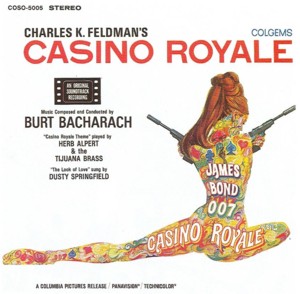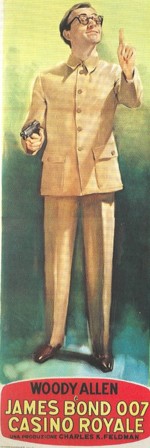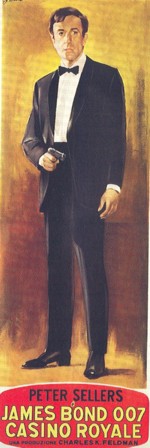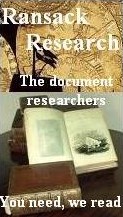| One of the great mysteries in film music history is why Burt Bacharach didn't score more movies. His score for Casino Royale (1967) is the one element of that troubled film that needs no apology. His other scores, for films like What's New Pussycat? (1965) and Butch Cassidy and the Sundance Kid (1969) contribute greatly to those films and show a flair for the demands of film scoring and the commercial market needs of popular music.
Bacharach was the wildly successful songwriter, and sometimes singer, who found pop music success in a string of enormously popular compositions, literally dozens of top 40 hits. He was riding the wave of this tsunami of creativity when Charles K. Feldman, producer of What's New Pussycat, offered him the assignment to score Casino Royale. The result was to be memorable. |
 |
The film had suffered setbacks and the result was an uneven film of varying moods and styles. Everything was big, big, big and its plethora of stars in bits and cameos actually worked against it.
 |
Bacharach's assured score provided a consistency that held the patchwork movie together. Besides it's uniformity, it was fun and sexy.
Originally released as a Colgems Lp (COSO-5005), the recording was later issued on a Varese Sarabande CD (VSD-5265). Both albums present the music out of sequence, front loading it with the two hit songs, "Casino Royale Theme," and "The Look of Love." It was a tradition of the Harry Saltzman-Albert Broccoli James Bond films to feature a current pop singer warbling the title theme of the movie. Since Casino Royale was competing with the "real" Bond films and, because this was a send up of those films, it was only right to one-up the official franchise by hiring not one, but two pop performers for song numbers.
Herb Alpert and the Tijuana Brass were engaged to perform "Casino Royale Theme." Alpert, who despite a legion of Big Band and Jazz trumpeters before him, may be the best remembered of them all.
At the time, Alpert's Tijuana Brass was the top-selling instrumental group along with The Ventures. Like The Ventures, the Tijuana Brass had a distinctive style that was immediately identifiable and generally spelled laid back fun. Alpert was a perfect match for Bacharach's loopy, horn heavy score, the composer's music often of a piece with Alpert's own work. And certainly, Alpert's pop sensibilities were at their height with Casino Royale.
|
Dusty Springfield was the second pop luminary connected with Casino Royale. Springfield drew the choice task of singing "The Look of Love," a beautiful and sexy song arranged somewhat in the vein of an Astrud Gilberto tune. Her smoky, sweet, sensual recording became an immediate hit single and was covered by dozens of other artists. This track is a full version of the song. In the film we do not hear her sing all of it, the demands of dialogue mandating that the instrumental version (also on this album) be used.
|
As the title might imply, "Home James, Don't Spare the Horses" is a galloping, slapsticky number with off-kilter syncopation that simulates a goofy horse ride (although no equine is present). A snippet is first heard when Mata Bond (Joanna Pettet) runs back to her room in the International Mothers Help building and then very soon afterwards as cabbie Carleton of the F.B.O. (Bernard Cribbins, famously funny in a Fawlty Towers episode) rescues her in a slapstick sequence involving a gaggle of international military men. The album version plays more fully.
"Sir James' Trip to Find Mata" is made up of three cues and arranged for the album out of order. The second part is heard first during the grouse hunt that is intended to kill Bond. Essentially, it is the "Casino Royale" theme. The first part is heard next at the
|
1) "Casino Royale Theme (Main Title)"
2) "The Venerable Sir James Bond"
3) "Sir James' Trip to Find Mata" (the middle theme)
4) "Sir James' Trip to Find Mata" (the first theme)
5) "Little French Boy"
6) "Moneypenny Goes for Broke"
7) "The Look of Love" (Dusty Springfield vocal)
8) "Sir James' Trip to Find Mata" (the third theme)
9) "First Stop Berlin"
10) "Home James, Don't Spare the Horses"
11) "Hi There Miss Goodthighs"
12) "Dream on James, You're Winning"
13) "The Look of Love" (instrumental)
14) "Le Chiffre's Torture of the Mind"
15) "Flying Saucer"
16) "The Big Cowboys and Indians Fight at Casino Royale; Casino Royale Theme) |
end of the sequence when Mimi (Deborah Kerr) professes her love for Bond (Niven) and runs off to a nunnery. It is played in a faux romantic style to match the deliberate over emphasis given by actress Kerr. This section is actually longer in the film than on the album. The third part isn't heard until much later in the film when Bond finally tracks down Mata Bond, his daughter by Mata Hari. Mata is introduced in an exotic dance number that starts slowly and steadily builds to an exciting conclusion.
| "Moneypenny Goes For Broke" and "Hi There Miss Goodthighs" are actually the same tune. The first arrangement enhances the scene wherein Moneypenny must test spy candidates and find that one irresistible man. The latter is a more languid rendition with a slightly more sensual emphasis and slightly different orchestration. It is used for the almost-love scene between Peter Sellers and a very young Jacqueline Bisset.
"Little French Boy" is a jaunty, upbeat passage with a goofy warbling saxophone. It reflects the cool of Sir James and his determination to outwit his enemies in the face of dire odds when they lure him down a country lane and send a remote-controlled milk wagon equipped with a bomb after him. This cue resurfaces late in the film during a fight between Bond and the Scottish boys from earlier in the movie. It is preceded by a new piece of action music and is edited to fit the scene.
"Flying Saucer -- First Stop Berlin" is really two cues set quite a bit apart in the movie and occurring in the opposite order of this track. "First Stop Berlin" is meant to reflect the seedy, red light district encountered by Mata Bond near the Berlin Wall, an interpolated Russian standard suggesting the Communist presence. It fades out quickly in the film when she enters the International Mothers Help building but this track continues to its musical resolution. A "Flying Saucer" puts down in Trafalgar Square and kidnaps Mata later in the film, an unexpected and exciting moment for all its absurdity, the music building to a satisfying crescendo. |
 |
A recurring theme for David Niven's Bond, the first part of "The Venerable Sir James Bond" is an exciting but laid back jazzy chase music as one might hear in the television version of The Saint. It is heard initially during the sequence early in the film that introduces Bond. It is coupled with music from a latter sequence when Bond is forced into a competition with some husky, kilted Scottish lads in which cannonball size concrete balls are picked up and thrown to your opponent. This sly, mischievous melody underscores Bond's easy mastery of the situation.
 |
"Dream on James, You're Winnning" uses an imitation Rudy Vallee singer complete with that 1920s crooner's trademark megaphone sonic. The music plays over a montage of druggy images after Evelyn Tremble (Peter Sellers) is slipped a mickey. The silly lyrics: "James Bond winning at Casino Royale, he won a lot of money and a gal at Casino Royale. Oh, he's not really such a wonderful spy, but winning lots of money and a gal he's a fabulous guy." This same singer is featured during the end credits but his vocal is not included on the album. As Tremble's dream stablizes and turns to thoughts of the ladies the music evolves into a slinky version of "The Look of Love."
The "The Big Cowboys and Indians Fight at Casino Royale; Casino Royale Theme" is considerably different in the film, repeating some passages and incorporating some other music. On this satisfying album version Bacharach goes all out in the Swingin' Sixties equivalent of a silent movie chase sequence, a tuba oompahing away. Niven's round-housing a circle of bad guys is amusingly "mickey moused" (musically matched punch for punch) with a musical merry-go-round treatment. When American Indians parachute into the action a clichèd Indian drumbeat is incorporated. Later, it gets a mock rock and roll arrangement. Throughout the chaos Dr. Noah/Jimmy Bond (Woody Allen) walks, each of his atomic belches, for he has swallowed a nuclear aspirin, accented with trumpets as he counts down to the last fatal belch. The final trumpet accent is present in this recording but missing in the movie. This is followed by a reprise of the "Casino Royale" theme, here presented as an instrumental whereas the movie includes some silly lyrics to help wrap up the story. |
Although there is more music in the film than is heard on this album, there is only one conspicuous absence. When Bond and company enter the underground realm of Dr. Noah there is a theme that we might as well name after him. This "Dr. Noah Theme" is heard in bits and pieces throughout the latter part of the film. Although it is given to us in bits and pieces, this somewhat ominous composition is developed throughout its playing time. It sounds as if it might have been possible to create an edit of all these pieces to create a coherent whole and a single track. At a mere 34:21 running time (actually, not that unusual for albums of the time) it could have used another couple of minutes.
Oddly, of all the Bond composer who came after John Barry, only Burt Bacharach managed to create a memorable score, albeit comedic. Bacharach's success and society's debt to him for the pleasure he has brought have been recognized by Mike Myers in his Austin Powers films, which borrow bits and pieces from Casino Royale. The Lp was a collector's item for some time and still can fetch a few dollars thanks to its 1960s kitsch cache and the suitable-for-framing cover art of a naked, tatooed girl with two silenced pistols.
If you want to sequence this album to more accurately reflect the order of cues as they are heard in the film here is a listing that might help:
Return to:
 |
Click on the icons for new features in The Thunder Child.
Radiation Theater: 1950s Sci Fi Movies Discussion Boards
The Sand Rock Sentinel: Ripped From the Headlines of 1950s Sci Fi Films
|
 |
|




